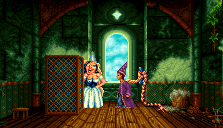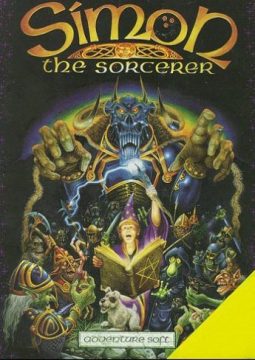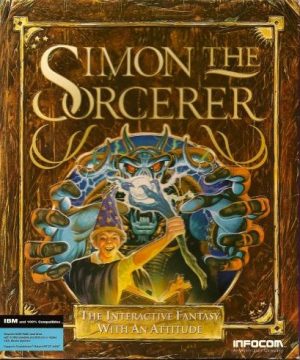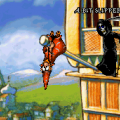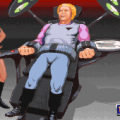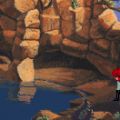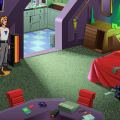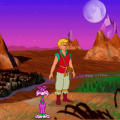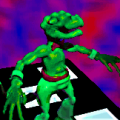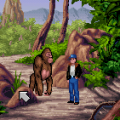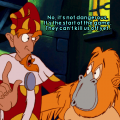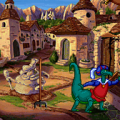For quite awhile, the adventure gaming scene was dominated by American companies like LucasArts and Sierra. That didn’t stop numerous other European outfits from trying their hands at things, and some of the better entries rival the quality of games from the other side of the pond. Adventure Soft’s Simon the Sorcerer is one such series.
It’s a bit of a weird situation – since the series’ inception, the Simon the Sorcerer games have been quite popular in their homeland of Great Britain, as well as the rest of Europe, but they never remotely caught on in North America. It’s not that the humor doesn’t translate – people all over still appreciate British classics like Monty Python’s Flying Circus and Fawlty Towers, or more recent series like The Office and The IT Crowd. It’s probably just a result of them not finding proper distribution, because any fan of British humour will find a lot to like in the Simon series.
It all began with Simon and Mike Woodroffe in the early ’80s, owners of a computer shop in Birmingham. Although they initially worked on porting Scott Adams’ text adventures to British micros, they eventually formed Horrorsoft and created a few games based on the horror hostess Elvira. After tiring of working on horror themed games, their name was changed to Adventure Soft, and they tried to obtain the license for Discworld, a series of comedic fantasy novels by Terry Pratchett. They weren’t able to, so they created their own fantasy universe in a similar style, and thus was born Simon the Sorcerer. (Another developer a few years down the line was able to secure the Discworld license for its own series of games, which turned out alright, although Simon is distinct enough to stand apart from its obvious inspiration.)
Simon the Sorcerer begins in the house of an average British teenager, whose dog wanders into the attic and disappears into a chest. Just a bit bewildered, Simon follows him, only to end up in a medieval realm called the Magic Kingdom. His quest, detailed by a note left on the table, is to rescue the good wizard Calypso, who has been kidnapped by the bad wizard Sordid. Although he wears a garish purple wizard outfit, complete with a goofy hat, Simon actually isn’t very skilled at magic… at least, at first. After wandering around the game world – which includes a small town and a fairly expansive forest – Simon will pick up a bit of skill to give him a fighting chance against the nefarious Sordid.
On the surface, Simon the Sorcerer also shares more than a few similarities with Monkey Island, which the Woodroffes acknowledge as an obvious inspiration. The menu bar is almost exactly the same, with a few verbs added in like “Wear” and “Consume”. Unfortunately it lacks the right-click context sensitive actions of LucasArts games, but the interface can highlight all of the hotspots on the screen, an extremely useful feature that also carried forward to most of the future games. If the interface design wasn’t a tip off, the quest starts off in much the same way – a young kid sets off on a simple quest through a fantasy environment, filled with bizarre and quirky characters. Even right at the beginning of the game you can walk into a bar, talk with some folks, and accomplish a few tasks to become a wizard.
Beyond that, though, the tone is actually quite a bit different, and that largely lies with the main character. In the first two Monkey Island games, Guybrush is a bit naive, maybe a bit of a troublemaker, and occasionally a bit sarcastic. By comparison, Simon is much, much snarkier. He doesn’t really want to be a wizard, and he certainly doesn’t want to save to kingdom; he just wants to get on with the whole spiel and find his way home. Nearly every character can be greeted with an insult and the rest of the conversations can be continued down much the same road. It might seem initially that Simon comes off a bit snotty, but to be fair, most of the other characters in the world are, in their own ways, stupid and annoying too, so they pretty much deserve any verbal beatdowns they have coming to them. It’s a very distinct character of British humour, and while it can be off-putting to some, it does give the game a fairly unique voice, even if initial appearances might prove otherwise. There’s also quite a bit of fourth wall breakage, not only with Simon turning to the screen and commenting, but with very explicit mentions about being in an adventure game.
Even though most of the characters you meet fall between “slightly odd” and “downright weird”, there’s some level of charm to most of them. Many parody well-known fantasy or fairy tale characters, so there’s usually something familiar but still a bit off about them. Near the beginning of the game Simon will come across what appears to be a talking tree stump, but is actually the home of a colony of woodworms, a species with a helium-pitched squeak and fine taste in mahogany. Another fisherman bears a suspicious resemblance to Gollum from The Lord of the Rings, but is in fact just a Tolkien fan wearing an elaborate costume. At the end of the game, you need to outwit a pair of evil looking demons named Gerard and Max who aren’t so much nefarious as just plain lazy (and also unhappy with their current employer). And then there’s the Swampling, a sad pathetic green Muppet-like creature with a lovingly overbearing demeanor who claims Simon as his bestest friend from the minute he walks in the door, and insists on feeding him his horrible, horrible swamp stew. No matter how many times you ditch his stew and run out the door when he’s not looking, he’s still just as happy to see you every time you revisit. Since the plot itself is so thin, all of the secondary cast really make up the core of the experience, and many have become recurring characters in later games.
A lot of the personality is sold through the voice acting, which is shockingly good for a CD-ROM game from the early ’90s. Chris Barrie (mostly known as the hologram humanoid Rimmer from the comedy sci-fi show Red Dwarf) supplies the voice of Simon, and although some of his readings sound a bit off, he still perfectly encapsulates the prankish and slightly bastardish nature of the character. The rest of the characters are pulled off pretty well too, even if some of the voice modulation makes them occasionally hard to understand. The only real downer is that there’s no way to enable subtitles in the CD-ROM version. If you want text, you’ll need to stick with the disk version, which naturally doesn’t contain any voice acting at all.
Your actual goals are somewhat vague, and there’s very little direction throughout. The game world is also quite large, with much of it contained within a forest in the middle of the map. The beginning of the game is quite tedious as you slog around, checking through different routes and discovering new areas, but you do have a magic map that lets you warp to major areas. It doesn’t allow you quick access to every screen, though, which still means you’ll need to do a bit of walking regardless. And Simon doesn’t walk so much as slog. Thankfully, if you’re using ScummVM, you can turn on the “fast” mode option to greatly speed things up, even though it screws up the timing of a few non-interactive events.
Due to the non-linear nature of the world, it can often be confusing to figure out your next goal, much less how to solve it. Sometimes it’ll make a bit of sense. At one point, you need to knock over a tree to get across a canyon. Simon can’t do it himself, but as luck has it, there’s a sleeping giant nearby. He’s snoozing too soundly for Simon to wake him up on his own, but if you’ve been exploring, you’ve probably come across the massively incompetent bard causing a cacophonous ruckus with a sousaphone. (The sound effects for this are simultaneously aggravating and hilarious.) Naturally, you need to figure out some way to steal it and use it, causing the giant to momentarily snap and knock over the tree.
Others are far, far more nebulous. In the screen after the giant, you come across a series of climbing pins, except one is missing. The game never tells you this, but it’s located in the house of a woodkeeper, which you access by giving him an axe, which is made of a non-copyright infringing mineral called milrith, which can only be found by tricking an archaeologist into digging in a specific spot, which can only be found if you have the metal detector, which you get by… you get the point. As a result, you end up aimlessly running around, running fetch quests and solving puzzles for the various inhabitants until you stumble across the proper items to let you proceed.
Still, even if there’s way too much lumbering around, at least there’s some gorgeous scenery. Unlike many other 256-color adventure games of the era, which relied on painted and scanned backgrounds, Simon the Sorcerer is pure 100% pixel artwork goodness, with lush green forests and mountainous terrain, all filled with animated niceties like scurrying woodland animals. The music is also fairly good, although there are only a few songs which quickly grow repetitive.
All and all it’s a nice bit of a classic, and definitely worthwhile material for retro gaming fans. The only true bummer is the somewhat rushed and unsatisfying ending. The game was released in North America via Activision’s Infocom label (the actual text adventure company had long been gutted by this point) but failed to gain much of any traction, sadly enough.
